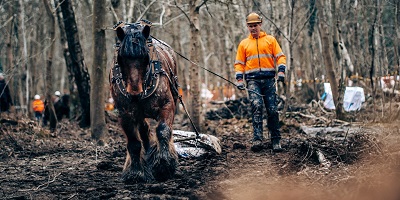Special guests on site
Three draught horses have been brought in recently to remove many of the big bags from the site.
These sealed bags contain bentonite collected manually from the work site following leaks.
Why use draught horses?
With the bentonite collected in big bags, the question was how to remove the bags safely without damaging the trees or forest floor (this particular part of the work site being in woodland). After careful consideration and discussion with environmental experts, it was decided to use draught horses. They are more agile than machinery, have less of an impact and are more adaptable to different types of terrain.
Needless to say, the work was undertaken in full compliance with animal welfare standards, as one of the horse handlers explains:
But what is bentonite?
Bentonite is a natural material. It is a kind of clay that is widely used in a number of fields (industry, cosmetics, agriculture, pharmaceuticals, construction, etc.).
Why is it used on the Elia work site?
Bentonite is used in directional drilling. Mixed with water, it acts, among other things, as a lubricant to help the drilling machine equipment move forward and stabilise the drilled 'tunnel'. Unfortunately, during the work, we noticed that some of this material was leaking.
What is the environmental impact of bentonite?
It is a natural product with very little, if any, impact on its environment.
What about at the Seraing site?
In the context of our work in Seraing, several people voiced concerns about the large quantities of bentonite being used. One of the risks mentioned was that it could have a potentially harmful effect on the soil, making it less permeable. To prevent this, various pieces of equipment (settlement tanks, straw filters) have been deployed on site. In the event of a bentonite leak, this equipment collects and contains the flow. If further leaks are detected outside these areas, the material is collected and deposited in sealed big bags for disposal.


